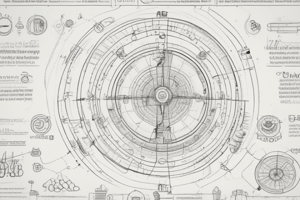Podcast
Questions and Answers
What is the primary focus of questionnaire design?
What is the primary focus of questionnaire design?
Relevance
What are the three key aspects to consider when phrasing a question?
What are the three key aspects to consider when phrasing a question?
Clarity, Unbiased, Answerable
Which of the following is NOT a type of problem question to avoid during questionnaire design?
Which of the following is NOT a type of problem question to avoid during questionnaire design?
- Loaded questions
- Burdensome questions
- Questions based on assumptions
- Double-barreled questions
- Ambiguous questions
- Complex questions
- Leading questions
- Open-ended questions (correct)
What is the primary objective of pretesting a questionnaire?
What is the primary objective of pretesting a questionnaire?
Which of the following is a guideline for questionnaire layout design?
Which of the following is a guideline for questionnaire layout design?
What is the purpose of a filter question in a survey?
What is the purpose of a filter question in a survey?
Which of the following is NOT a general guideline for organizing questions in a survey?
Which of the following is NOT a general guideline for organizing questions in a survey?
It is recommended to place sensitive or difficult questions at the beginning of a survey.
It is recommended to place sensitive or difficult questions at the beginning of a survey.
Demographic questions should be included at the end of a survey.
Demographic questions should be included at the end of a survey.
What is a primary reason to conduct multiple rounds of revisions before finalizing a questionnaire?
What is a primary reason to conduct multiple rounds of revisions before finalizing a questionnaire?
Which of these is NOT a type of scale used in questionnaire design?
Which of these is NOT a type of scale used in questionnaire design?
Constant-Sum scales require respondents to allocate a fixed number of points across different attributes.
Constant-Sum scales require respondents to allocate a fixed number of points across different attributes.
What are some examples of common attributes measured using a category scale?
What are some examples of common attributes measured using a category scale?
What are two potential drawbacks of a 'Pick One' question format?
What are two potential drawbacks of a 'Pick One' question format?
What is the primary objective of a 'Pick All That Apply' question format?
What is the primary objective of a 'Pick All That Apply' question format?
Ranking scales require respondents to place items in order of preference based on specific criteria.
Ranking scales require respondents to place items in order of preference based on specific criteria.
The results of a Ranking Scale are only relevant in the context of the options provided.
The results of a Ranking Scale are only relevant in the context of the options provided.
Semantic Differential scales employ a continuum with opposing adjectives at each end.
Semantic Differential scales employ a continuum with opposing adjectives at each end.
Likert scales measure respondents' level of agreement or disagreement with a statement.
Likert scales measure respondents' level of agreement or disagreement with a statement.
What are the advantages of using a 5-point Likert scale compared to a 7-point scale?
What are the advantages of using a 5-point Likert scale compared to a 7-point scale?
The order of questions in a survey can significantly impact the reliability of respondents' answers.
The order of questions in a survey can significantly impact the reliability of respondents' answers.
It is always recommended to avoid using any extra elements or graphics in a questionnaire, focusing solely on the content.
It is always recommended to avoid using any extra elements or graphics in a questionnaire, focusing solely on the content.
When pretesting a questionnaire, what aspects should be prioritized?
When pretesting a questionnaire, what aspects should be prioritized?
Flashcards
Questionnaire Design
Questionnaire Design
Designing a set of questions to gather data for research objectives, ensuring standardized wording and sequence for easy coding and managerial recommendations.
Objectives of Questionnaire Design
Objectives of Questionnaire Design
Ensuring the questionnaire addresses research questions and sample characteristics accurately
Relevance in Questionnaire Design
Relevance in Questionnaire Design
Gathering all necessary information to understand and answer research questions regarding the sample.
Problematic Question: Complexity
Problematic Question: Complexity
Signup and view all the flashcards
Problematic Question: Leading
Problematic Question: Leading
Signup and view all the flashcards
Problematic Question: Loaded
Problematic Question: Loaded
Signup and view all the flashcards
Problematic Question: Ambiguity
Problematic Question: Ambiguity
Signup and view all the flashcards
Problematic Question: Double-barreled
Problematic Question: Double-barreled
Signup and view all the flashcards
Problematic Question: Assumptions
Problematic Question: Assumptions
Signup and view all the flashcards
Problematic Question: Burdensome
Problematic Question: Burdensome
Signup and view all the flashcards
Choice Scales
Choice Scales
Signup and view all the flashcards
Ranking Scales
Ranking Scales
Signup and view all the flashcards
Rating Scales
Rating Scales
Signup and view all the flashcards
Filter Questions
Filter Questions
Signup and view all the flashcards
Funnel Approach
Funnel Approach
Signup and view all the flashcards
Order Bias
Order Bias
Signup and view all the flashcards
Questionnaire Revision
Questionnaire Revision
Signup and view all the flashcards
Pretesting
Pretesting
Signup and view all the flashcards
Pretest: Expert Input
Pretest: Expert Input
Signup and view all the flashcards
Pretest: Informed Respondent
Pretest: Informed Respondent
Signup and view all the flashcards
Pretest: Respondent Feedback
Pretest: Respondent Feedback
Signup and view all the flashcards
Sensitive Questions
Sensitive Questions
Signup and view all the flashcards
Questionnaire Layout
Questionnaire Layout
Signup and view all the flashcards
Study Notes
Questionnaire Design
- Questionnaire design objectives include creating a set of questions to gather necessary data to fulfill research project goals.
- Ensuring standardized wording and question order across the questionnaire is critical.
- The questionnaire should be easily coded and translated into actionable managerial recommendations.
Basic Considerations
- What to ask? Focus on relevance. Collect all data needed to address the research questions and provide an accurate sample description.
- How to phrase questions? Use clear, unbiased wording, and ensure questions are answerable. Avoid complex, leading, loaded, ambiguous, double-barreled, and burdensome questions. Use appropriate scales (e.g., select, ranking, rating, category, Likert, semantic differential).
- Question Sequence? The order of questions affects responses, both intentionally and unintentionally. Earlier questions can influence subsequent responses, and the order of answer choices matters. Use a funnel approach, putting general questions first, progressing to more specific ones. Demographic questions should appear at the end.
- Revision Needed? Multiple rounds of questionnaire revision are common and necessary. Revision continues until all researchers and clients agree.
- Pretesting? This evaluates how well respondents understand the questions and identifies missing, ambiguous, biased, or problematic questions. Experts, informed respondents, and general respondents can be involved.
- Layout? Focus on readability, with clear reproduction quality. Avoid crowding on the page, and allow ample space, use an easy-to-read font and color contrast. Use "extras" sparingly.
Consideration 1: What Questions to Ask?
- Gather all necessary information for research questions and example description of samples.
- The focus should remain on the relevance of the questions and the sample.
Consideration 2: How Questions Should Be Phrased?
- Word choice, scale selection, and question-answer clarity are vital.
- Avoid confusing, biased, or ambiguous questions.
Consideration 3: What Order Questions Should Be Asked In?
- Questionnaire order affects responses, potentially unconsciously.
- Sensitive questions and issues should be placed toward the end of the questionnaire.
- The order of answer choices impacts respondents' selections.
Consideration 4: Revision Needed?
- Questionnaires often require multiple revisions.
- Revisions should occur until all researchers and clients attain agreement.
Consideration 5: Pretesting
- Pretests help determine if respondents understand questionnaire questions.
- Pretests identify missing, ambiguous, biased, or problematic questionnaire questions.
- Three pretest groups include experts, informed respondents, and general respondents.
Consideration 6: Questionnaire Layout
- Focus on questionnaire readability.
- Prioritize clarity of reproduction and spacing within the questionnaire.
- Avoid crowding and use "extras" sparingly.
Studying That Suits You
Use AI to generate personalized quizzes and flashcards to suit your learning preferences.




